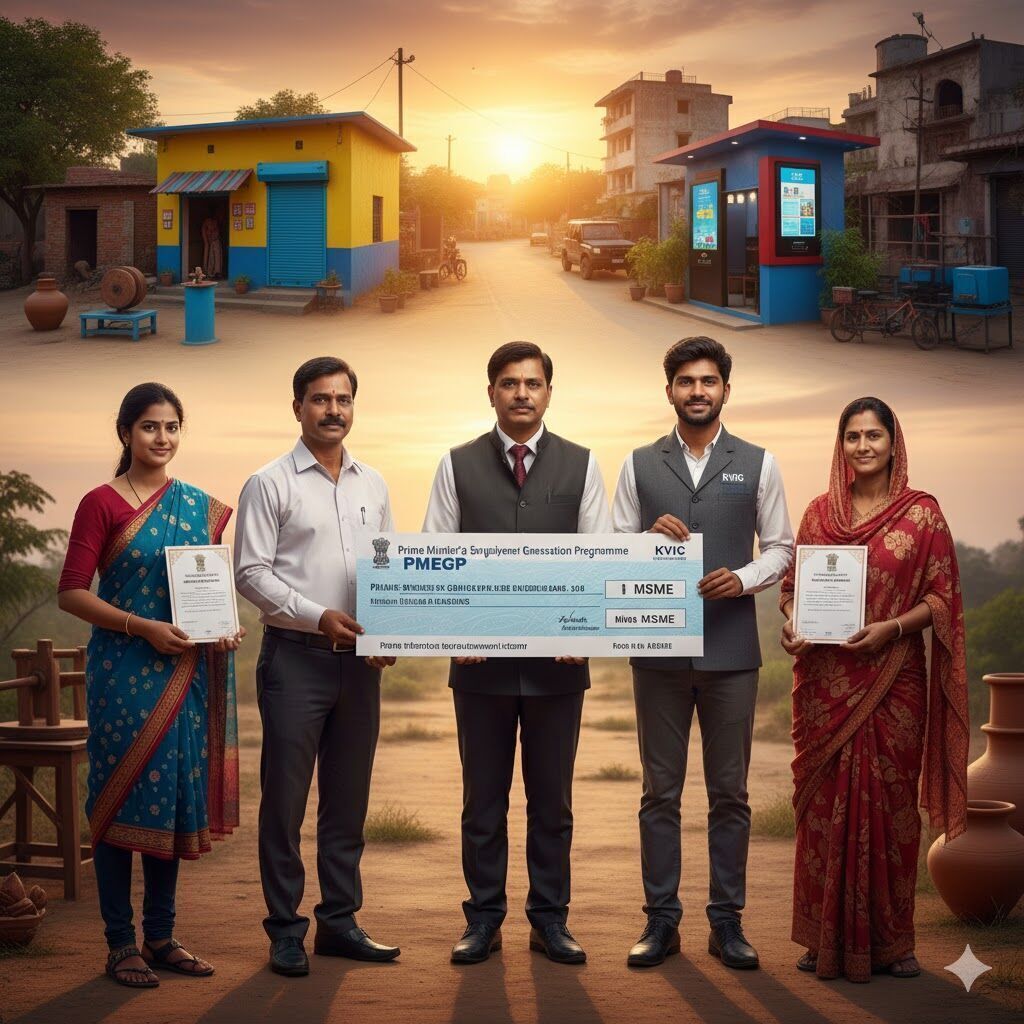Prime Minister’s Employment Generation Programme (PMEGP)
Ministry: Ministry of Micro, Small and Medium Enterprises (MSME)
Category: Entrepreneurship, Employment, Financial Assistance, Loan, MSME | State/UT: All India | Central: Yes

About Scheme
Launched in August 2008, the Prime Minister’s Employment Generation Programme (PMEGP) is a credit-linked subsidy scheme administered by the Ministry of MSME. It aims to generate employment opportunities through the establishment of micro-enterprises in the non-farm sector for both rural and urban areas. PMEGP was formed by merging PMRY and REGP schemes and continues under the 15th Finance Commission cycle (2021–26) with a total outlay of ₹13,554.42 Crore to create 30 lakh jobs via 4 lakh projects.
Objectives
- Generate employment in rural and urban areas through new self-employment ventures.
- Promote traditional artisans and unemployed youth by supporting micro-enterprises.
- Provide sustainable livelihood and reduce migration from rural to urban areas.
- Enhance productivity and wage-earning capacity of artisans and workers.
Implementing Agencies
- National level: Khadi and Village Industries Commission (KVIC)
- State level: KVIC State Offices, KVIBs, District Industries Centres (DICs), Coir Board, and partner banks
Eligibility
For new enterprises:
- Any individual above 18 years of age.
- No income ceiling for assistance.
- For projects above ₹10 lakh (manufacturing) or ₹5 lakh (service), the applicant must have at least 8th pass qualification.
- Assistance is available only for new projects under PMEGP (not existing government-supported ones).
For upgradation of existing PMEGP/REGP/MUDRA units:
- Margin Money subsidy of the first loan must be successfully adjusted after the 3-year lock-in period.
- First loan repaid successfully.
- Unit must be profit-making and show growth potential.
- Priority to applicants affected by natural disasters.
Benefits
Benefits under PMEGP include:
1️⃣ **Financial Assistance / Subsidy (Margin Money)**
- Funds provided as subsidy for setting up new micro-enterprises or upgrading existing ones.
- ₹100 Crore per FY earmarked for upgradation of existing PMEGP/REGP/MUDRA units.
2️⃣ **Backward and Forward Linkages (5% of Annual Allocation)**
- Used for awareness camps, training, monitoring, exhibitions, IT upgrades, and entrepreneur facilitation.
3️⃣ **Support Levels:**
- For New Micro-Enterprises:
- **General Category:** Beneficiary contribution – 10% of project cost.
- Subsidy: 15% (Urban) or 25% (Rural).
- **Special Category** (SC/ST/OBC/Women/Ex-servicemen/Transgender/Divyang/NER/Hill/Border/Aspirational):
- Beneficiary contribution – 5% of project cost.
- Subsidy: 25% (Urban) or 35% (Rural).
- Maximum project cost:
- ₹50 lakh for Manufacturing sector.
- ₹20 lakh for Service/Business sector.
- For Upgradation (2nd Loan):
- Beneficiary contribution – 10%.
- Subsidy – 15% (20% in NER and Hill States).
- Maximum project cost:
- ₹10 crore (Manufacturing), subsidy ₹15 lakh (₹20 lakh for NER/Hill).
- ₹25 lakh (Service), subsidy ₹3.75 lakh (₹5 lakh for NER/Hill).
- Excess project cost (beyond cap) financed by banks without subsidy.
⚙️ **Conditions:**
- All payments must be through bank-approved channels.
- Only one person per family eligible.
- Projects in the negative list (tobacco, liquor, meat, hotels serving alcohol, crop cultivation, etc.) are excluded.
- Units must adhere to local environmental and socio-economic norms.
Application Process
Online:
1. Visit https://www.kviconline.gov.in/pmegpeportal/pmegphome/index.jsp or https://www.kviconline.gov.in/pmegpeportal/pmegphome/index.jsp
2. Click “Apply” under the respective tab:
- “Application for New Unit” or
- “Application for Existing Unit (2nd Loan)”
3. Fill out all details, upload documents, and submit.
4. Track application using the registered User ID on the portal.
Offline:
1. Visit the nearest DIC/KVIC/KVIB office.
2. Submit filled form with supporting documents.
3. Application will be verified and forwarded to banks for processing and approval.
Documents Required
1. Caste Certificate
2. Special Category Certificate (if applicable)
3. Rural Area Certificate
4. Detailed Project Report
5. Education / EDP / Skill Development Certificate
6. Aadhaar and PAN Card
7. Bank Account Proof
8. Any other applicable supporting documents
Get More Updates
Follow us on social media for the latest government schemes and notifications:
